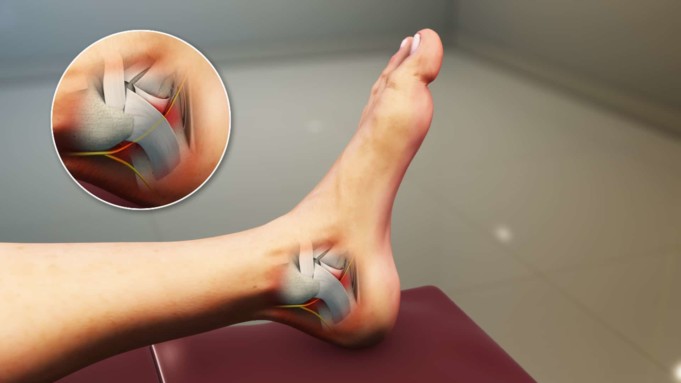The condition caused by continuous pressure that leads to the damage on the posterior tibial nerve is referred to as Tarsal tunnel syndrome.
The tibial nerve branches right off of the sciatic nerve found near the ankle.
The tibial nerve channels through the tarsal tunnel. This is a narrow passage inside the ankle that is fused by bone and tissue. The tibial nerve is damaged when the nerve is pressed as a result of constant pressure.
Symptoms
People who suffer from tarsal tunnel syndrome may experience numbness, pain, or tingling. The pain is commonly felt around the tibial nerve, but generally, the pain is frequently felt inside the ankle or in the sore of the foot.
The pain can feel like;
- An electric shock
- Sharp shooting pain
- Needle and pin-like pain
- Burning sensation
Symptoms differ greatly depending on the person with the tarsal tunnel syndrome. Some individuals experience symptoms that gradually progress, while others experience symptoms that can begin very suddenly.
Pain, numbness, and other symptoms are often intensified by physical activity. However, some individuals experience tingling and pain at night or when they are resting if the condition is persistent.
Causes
Tarsal tunnel syndrome results from tightening of the tibial nerve, and it’s typically caused by other conditions.
Causes of tarsal tunnel syndrome could include;
- Benign bony growth
- Very flat feet, especially since flattened feet can slack the tibial nerve
- Trauma or injuries, like fracture or ankle sprain
- Inflammation from arthritis
- Masses and lesions like tumors or lipomas close to the tibial nerve
- Diabetes, which can cause the nerve to be vulnerable to constriction
- Varicose veins
Diagnosing Tarsal Tunnel Syndrome
You should consult with your doctor immediately if you suspect you have tarsal tunnel syndrome, so the cause of the condition can be identified. Your doctor or healthcare provider can help you with treatment options, so the condition isn’t aggravated.
You may also be advised to meet a podiatrist or an orthopedic surgeon.
Your doctor would ask about the progression of your symptoms during your appointment. They may also inquire about your medical history and possible traumatic experiences that may have affected your ankle.
Your ankle and foot would be examined to check for physical characteristics that could suggest the presence of tarsal tunnel syndrome. A Tinel’s test is likely to be carried out, which involves the gentle tapping of the tibial nerve.
When pain or tingling sensation is felt as a result of the pressure, then this is an indication of tarsal tunnel syndrome.
Additional tests may also be required to check for underlying causes, and this may include electromyography. This is a test that is done to detect nerve dysfunction.
An MRI may also be needed if your doctor suspects a bony growth or a mass that could be causing the tarsal tunnel syndrome.
Can tarsal tunnel syndrome lead to any complications?
When left untreated, tarsal tunnel syndrome can lead to permanent, irreparable damage. This could lead to nerve damage, hence affecting normal activities such as walking or running.
Treatment
The treatment of tarsal tunnel syndrome solely depends on the symptoms of a person with the condition and the underlying cause of your pain.
Home treatments
Anti-inflammatory medications can be taken to reduce inflammation. This can help to soothe compression of the affected nerve. Icing, resting, elevation, and compression, known as “rice treatment,” can also be used to reduce inflammation and swelling.
Doctor-prescribed treatments
Steroid treatment “injections” may also be administered to the affected area to minimize swelling. Splits and braces may be used in some cases to immobilize the affected foot and reduce movement that could increase swelling in the nerve.
A person with flat feet suffering from tarsal tunnel syndrome may want to have their shoes customized to help support unbalanced arches affecting the feet.
Surgery
In cases where the condition is severe and long-term, your medical doctor may suggest an operation known as the tarsal tunnel release. This involves the surgical incision from behind the ankle down the arch of the foot.
The ligament is then released, causing relief in the nerve. Slightly invasive surgery is also used by some specialists, in which much smaller cuts are made inside the ankle.
Tiny instruments are used by the surgeon to stretch out the ankle’s ligament. The risk of complications, as well as recovery time, is lessened since there’s minimal trauma sustained by the tissue.
Outlook
Tarsal tunnel syndrome can be managed and even cured with a wide range of treatment options. Nevertheless, it is best to get treatment early to avoid permanent nerve damage.
Have you had to deal with Tarsal Tunnel Syndrome before? What treatment options did you use? How long did it take for you to heal? Share your thoughts with us in the comments below.












